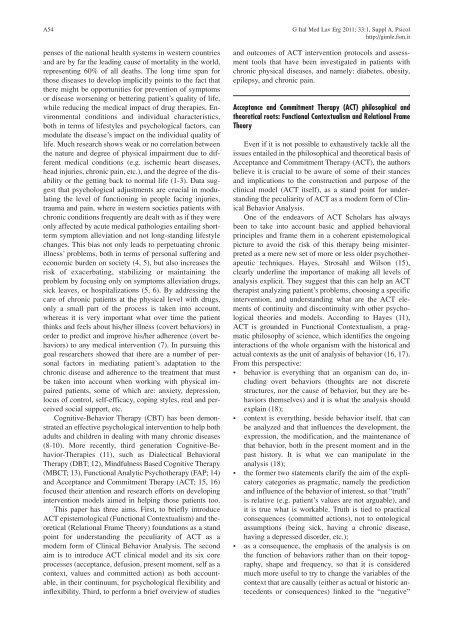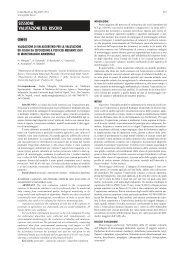Acceptance and commitment therapy (ACT) - Giornale Italiano di ...
Acceptance and commitment therapy (ACT) - Giornale Italiano di ...
Acceptance and commitment therapy (ACT) - Giornale Italiano di ...
You also want an ePaper? Increase the reach of your titles
YUMPU automatically turns print PDFs into web optimized ePapers that Google loves.
A54<br />
penses of the national health systems in western countries<br />
<strong>and</strong> are by far the lea<strong>di</strong>ng cause of mortality in the world,<br />
representing 60% of all deaths. The long time span for<br />
those <strong>di</strong>seases to develop implicitly points to the fact that<br />
there might be opportunities for prevention of symptoms<br />
or <strong>di</strong>sease worsening or bettering patient’s quality of life,<br />
while reducing the me<strong>di</strong>cal impact of drug therapies. Environmental<br />
con<strong>di</strong>tions <strong>and</strong> in<strong>di</strong>vidual characteristics,<br />
both in terms of lifestyles <strong>and</strong> psychological factors, can<br />
modulate the <strong>di</strong>sease’s impact on the in<strong>di</strong>vidual quality of<br />
life. Much research shows weak or no correlation between<br />
the nature <strong>and</strong> degree of physical impairment due to <strong>di</strong>fferent<br />
me<strong>di</strong>cal con<strong>di</strong>tions (e.g. ischemic heart <strong>di</strong>seases,<br />
head injuries, chronic pain, etc.), <strong>and</strong> the degree of the <strong>di</strong>sability<br />
or the getting back to normal life (1-3). Data suggest<br />
that psychological adjustments are crucial in modulating<br />
the level of functioning in people facing injuries,<br />
trauma <strong>and</strong> pain, where in western societies patients with<br />
chronic con<strong>di</strong>tions frequently are dealt with as if they were<br />
only affected by acute me<strong>di</strong>cal pathologies entailing shortterm<br />
symptom alleviation <strong>and</strong> not long-st<strong>and</strong>ing lifestyle<br />
changes. This bias not only leads to perpetuating chronic<br />
illness’ problems, both in terms of personal suffering <strong>and</strong><br />
economic burden on society (4, 5), but also increases the<br />
risk of exacerbating, stabilizing or maintaining the<br />
problem by focusing only on symptoms alleviation drugs,<br />
sick leaves, or hospitalizations (5, 6). By addressing the<br />
care of chronic patients at the physical level with drugs,<br />
only a small part of the process is taken into account,<br />
whereas it is very important what over time the patient<br />
thinks <strong>and</strong> feels about his/her illness (covert behaviors) in<br />
order to pre<strong>di</strong>ct <strong>and</strong> improve his/her adherence (overt behaviors)<br />
to any me<strong>di</strong>cal intervention (7). In pursuing this<br />
goal researchers showed that there are a number of personal<br />
factors in me<strong>di</strong>ating patient’s adaptation to the<br />
chronic <strong>di</strong>sease <strong>and</strong> adherence to the treatment that must<br />
be taken into account when working with physical impaired<br />
patients, some of which are: anxiety, depression,<br />
locus of control, self-efficacy, coping styles, real <strong>and</strong> perceived<br />
social support, etc.<br />
Cognitive-Behavior Therapy (CBT) has been demonstrated<br />
an effective psychological intervention to help both<br />
adults <strong>and</strong> children in dealing with many chronic <strong>di</strong>seases<br />
(8-10). More recently, third generation Cognitive-Behavior-Therapies<br />
(11), such as Dialectical Behavioral<br />
Therapy (DBT; 12), Mindfulness Based Cognitive Therapy<br />
(MBCT; 13), Functional Analytic Psycho<strong>therapy</strong> (FAP; 14)<br />
<strong>and</strong> <strong>Acceptance</strong> <strong>and</strong> Commitment Therapy (<strong>ACT</strong>; 15, 16)<br />
focused their attention <strong>and</strong> research efforts on developing<br />
intervention models aimed in helping those patients too.<br />
This paper has three aims. First, to briefly introduce<br />
<strong>ACT</strong> epistemological (Functional Contextualism) <strong>and</strong> theoretical<br />
(Relational Frame Theory) foundations as a st<strong>and</strong><br />
point for underst<strong>and</strong>ing the peculiarity of <strong>ACT</strong> as a<br />
modern form of Clinical Behavior Analysis. The second<br />
aim is to introduce <strong>ACT</strong> clinical model <strong>and</strong> its six core<br />
processes (acceptance, defusion, present moment, self as a<br />
context, values <strong>and</strong> committed action) as both accountable,<br />
in their continuum, for psychological flexibility <strong>and</strong><br />
inflexibility. Third, to perform a brief overview of stu<strong>di</strong>es<br />
G Ital Med Lav Erg 2011; 33:1, Suppl A, Psicol<br />
http://gimle.fsm.it<br />
<strong>and</strong> outcomes of <strong>ACT</strong> intervention protocols <strong>and</strong> assessment<br />
tools that have been investigated in patients with<br />
chronic physical <strong>di</strong>seases, <strong>and</strong> namely: <strong>di</strong>abetes, obesity,<br />
epilepsy, <strong>and</strong> chronic pain.<br />
<strong>Acceptance</strong> <strong>and</strong> Commitment Therapy (<strong>ACT</strong>) philosophical <strong>and</strong><br />
theoretical roots: Functional Contextualism <strong>and</strong> Relational Frame<br />
Theory<br />
Even if it is not possible to exhaustively tackle all the<br />
issues entailed in the philosophical <strong>and</strong> theoretical basis of<br />
<strong>Acceptance</strong> <strong>and</strong> Commitment Therapy (<strong>ACT</strong>), the authors<br />
believe it is crucial to be aware of some of their stances<br />
<strong>and</strong> implications to the construction <strong>and</strong> purpose of the<br />
clinical model (<strong>ACT</strong> itself), as a st<strong>and</strong> point for underst<strong>and</strong>ing<br />
the peculiarity of <strong>ACT</strong> as a modern form of Clinical<br />
Behavior Analysis.<br />
One of the endeavors of <strong>ACT</strong> Scholars has always<br />
been to take into account basic <strong>and</strong> applied behavioral<br />
principles <strong>and</strong> frame them in a coherent epistemological<br />
picture to avoid the risk of this <strong>therapy</strong> being misinterpreted<br />
as a mere new set of more or less older psychotherapeutic<br />
techniques. Hayes, Strosahl <strong>and</strong> Wilson (15),<br />
clearly underline the importance of making all levels of<br />
analysis explicit. They suggest that this can help an <strong>ACT</strong><br />
therapist analyzing patient’s problems, choosing a specific<br />
intervention, <strong>and</strong> underst<strong>and</strong>ing what are the <strong>ACT</strong> elements<br />
of continuity <strong>and</strong> <strong>di</strong>scontinuity with other psychological<br />
theories <strong>and</strong> models. Accor<strong>di</strong>ng to Hayes (11),<br />
<strong>ACT</strong> is grounded in Functional Contextualism, a pragmatic<br />
philosophy of science, which identifies the ongoing<br />
interactions of the whole organism with the historical <strong>and</strong><br />
actual contexts as the unit of analysis of behavior (16, 17).<br />
From this perspective:<br />
• behavior is everything that an organism can do, inclu<strong>di</strong>ng<br />
overt behaviors (thoughts are not <strong>di</strong>screte<br />
structures, nor the cause of behavior, but they are behaviors<br />
themselves) <strong>and</strong> it is what the analysis should<br />
explain (18);<br />
• context is everything, beside behavior itself, that can<br />
be analyzed <strong>and</strong> that influences the development, the<br />
expression, the mo<strong>di</strong>fication, <strong>and</strong> the maintenance of<br />
that behavior, both in the present moment <strong>and</strong> in the<br />
past history. It is what we can manipulate in the<br />
analysis (18);<br />
• the former two statements clarify the aim of the explicatory<br />
categories as pragmatic, namely the pre<strong>di</strong>ction<br />
<strong>and</strong> influence of the behavior of interest, so that “truth”<br />
is relative (e.g. patient’s values are not arguable), <strong>and</strong><br />
it is true what is workable. Truth is tied to practical<br />
consequences (committed actions), not to ontological<br />
assumptions (being sick, having a chronic <strong>di</strong>sease,<br />
having a depressed <strong>di</strong>sorder, etc.);<br />
• as a consequence, the emphasis of the analysis is on<br />
the function of behaviors rather than on their topography,<br />
shape <strong>and</strong> frequency, so that it is considered<br />
much more useful to try to change the variables of the<br />
context that are causally (either as actual or historic antecedents<br />
or consequences) linked to the “negative”

















